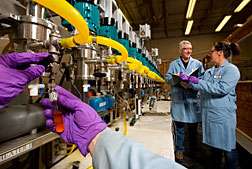Extracting rare earth materials from consumer products

In a new twist on the state's mining history, a group of Idaho scientists will soon be crushing consumer electronics rather than rocks in a quest to recover precious materials. DOE's Ames Laboratory will lead the new Critical Materials Innovation Hub, and Idaho National Laboratory scientists will contribute to that effort. They'll apply expertise gleaned from recycling fissionable material from nuclear fuel to separate rare earth metals and other critical materials from crushed consumer products.
So-called rare earth elements—many of which can be found floating at the bottom of a standard periodic table—likely aren't far from where you're sitting. The bright red in that smartphone text or image: Europium. Powerful magnets driving electric motors in everything from wind turbines to vehicles to hand tools: Dysprosium, Neodymium. Phosphors coating the innards of energy-efficient light bulbs: Terbium, Yttrium, Europium.
Many of these elements are the same ones nuclear reprocessing research has targeted for years. They're members of the lanthanide family of elements, which inhibit the fission process but are chemically similar to fissionable actinides. INL scientists have a long history of expertise devising new ways to effectively separate lanthanides from complex mixtures.
INL will now apply that expertise to recycle rare earth and other critical elements from discarded electronics. The team will develop and test new processing methods that selectively recover critical metals using supercritical fluids, membranes and electrochemical approaches. These advanced separation techniques might also help mining operations by boosting extraction from raw ore. Because these materials are subject to supply disruptions, the DOE is investing in solutions to potential domestic shortages.
Provided by US Department of Energy




















